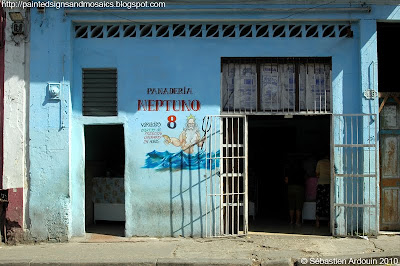
Grocery &
Oil Stores
All Household Requisites
Location: Queen Street / Picture taken on: 14/03/2008
A record of painted adverts and doorstep mosaics from Britain, France, Germany and other parts of the world, and the story behind some of them.












 The upper sign was painted twice. The original sign advertized a
The upper sign was painted twice. The original sign advertized a



| Panadería Neptuno 8 Variados ofertas de productos liberados 24 horas | Bakery Neptuno 8 Various Offers of Products At Free Market Prices Open 24 Hours |


| Redfern's Rubber Heels Save Money | Cheapest & Best In Fulham For Leather | Redfern's Rubber Heels Make Walking A Pleasure |








Ernest Doe & Sons Ltd, agricultural engineers and agents of Fulbourn, near Cambridge, have taken over the Ford tractor and agricultural engineering side of the business of James Graven & Sons Ltd, 17 High Street, Chatteris, Cambs, and Broad Street, Ely. The service will be continued at Ely and Fulbourn.Since then James Graven has been specialising in retailing, in particular of locally-produced food, and runs several shops in partnership with Budgens, BP and Spar in the Ely - Cambridge area.




| Maltsters | G. & W. E. Downing | ...s |
| Head Office Spon Lane Smethwick |


| G. & W. E. Downing Maltsters Head Office Spon Lane Smethwick Branch Malt... [Malthouses] |
| Smethwick * Birmingham * West Bromwich * Wednesbury * Blackheath Walsall * ... | Bristol * .a.. Tewkesbury * Gloucester * Oswestry * ... Oxford * |
| And London |














| Droguerie |
| Spécialité de peintures | Brosses - Pinceaux |
| Hardware Shop |
| Paints a Speciality | Brushes - Paint Brushes |
 Unfortunately too much of it disappeared when the first-floor window was opened for me to be able to recognize this logo. The entrance to the shop though is worth noticing.
Unfortunately too much of it disappeared when the first-floor window was opened for me to be able to recognize this logo. The entrance to the shop though is worth noticing. A difficult one to read as there are two signs.
A difficult one to read as there are two signs. 

 The premises housed once a
The premises housed once a  Here as well, I can spot many letters but they don't make much sense.
Here as well, I can spot many letters but they don't make much sense.


 There are at least three superimposed layers there. The oldest one ended with
There are at least three superimposed layers there. The oldest one ended with 
| Les ... ...e Château de Cognac Musée François Ier S'adresser au concierge | The ... ... Cognac Castle François I Museum See With the Caretaker |
| Si vous le souhaitez, vous pouvez m'écrire en français. | |
| Si lo desean, me pueden escribir en castellano. | |
| Wenn Sie wünschen, können Sie mir auf Deutsch schreiben. |
